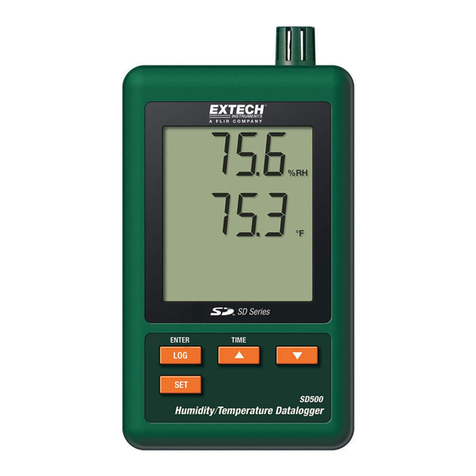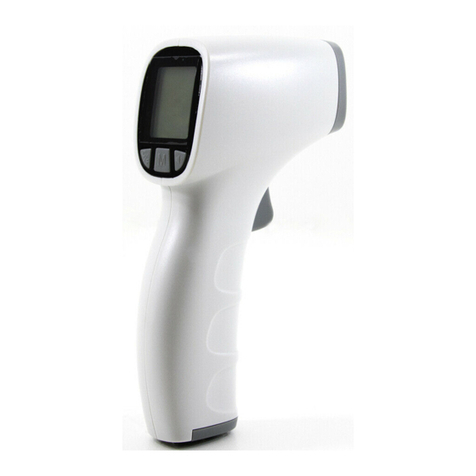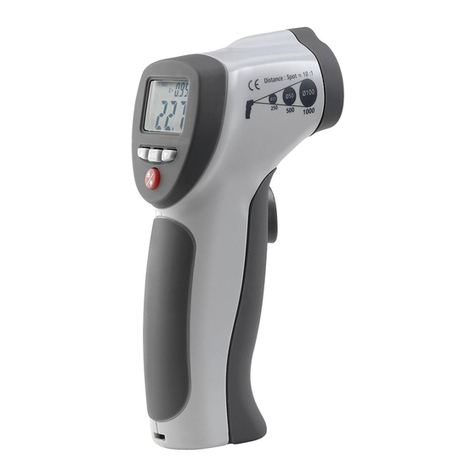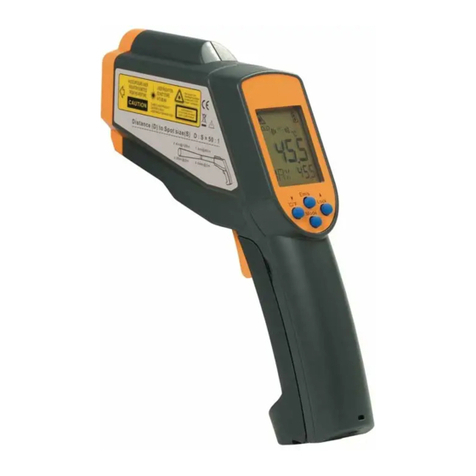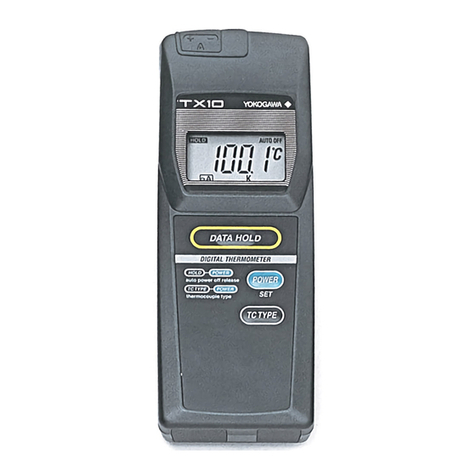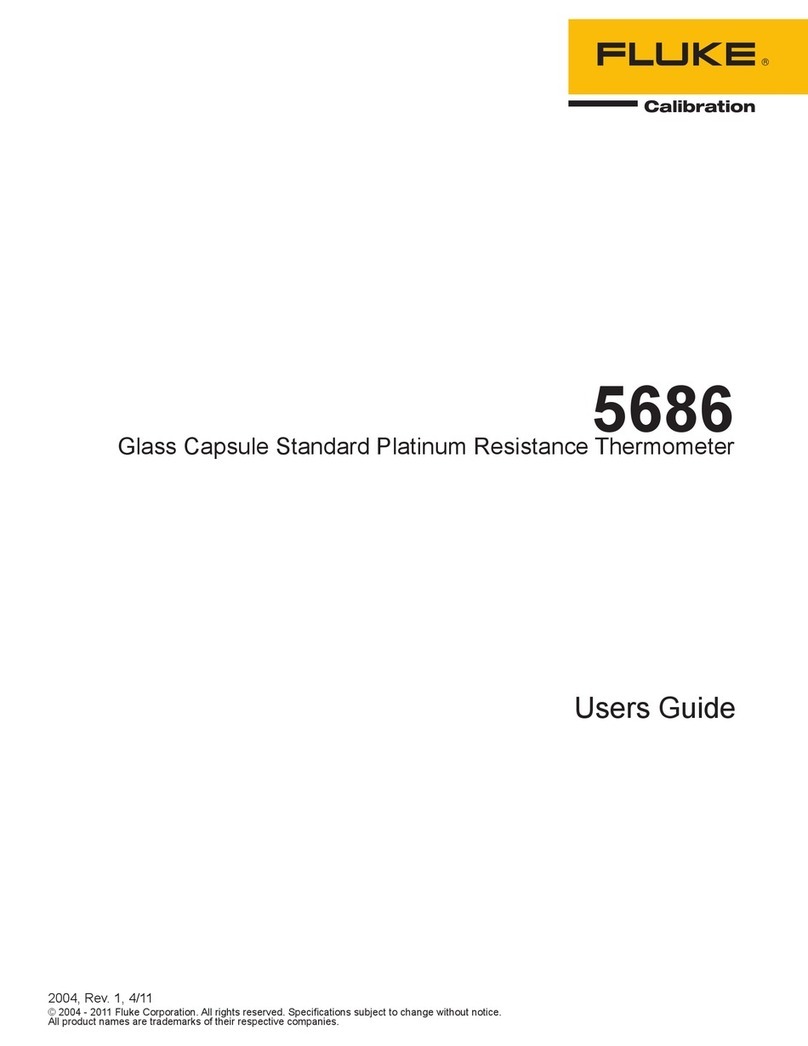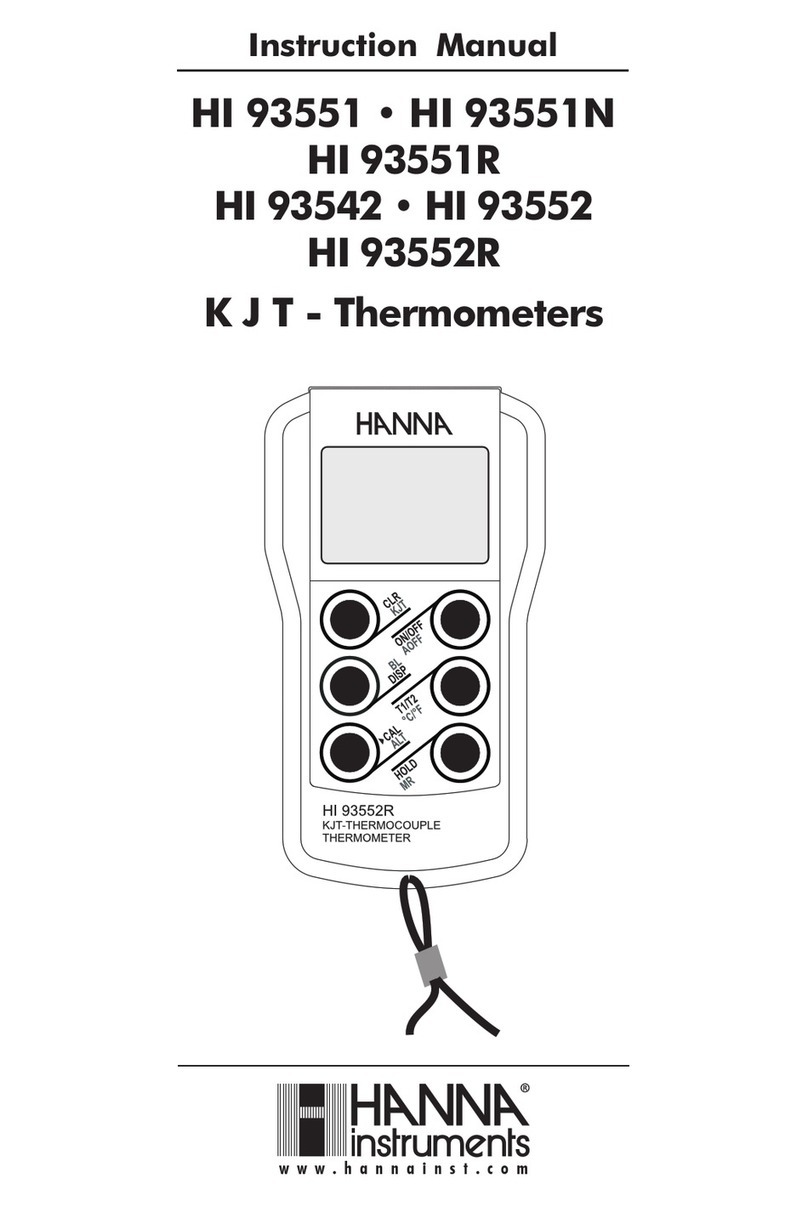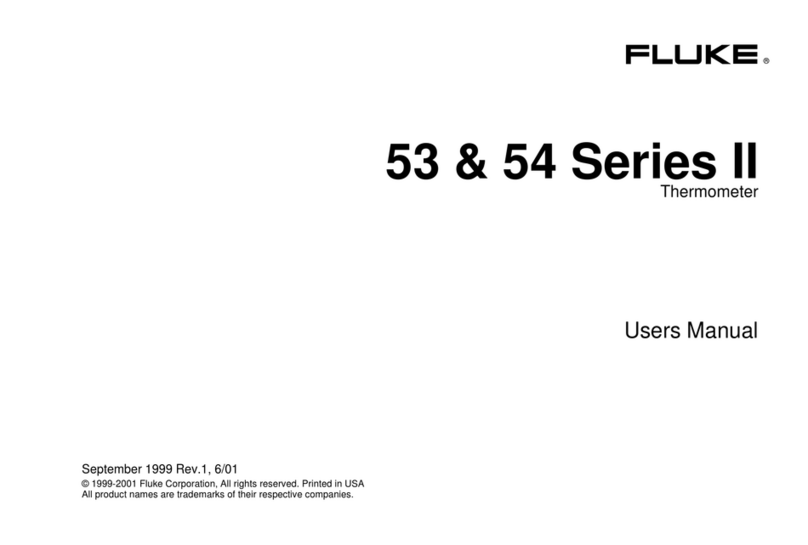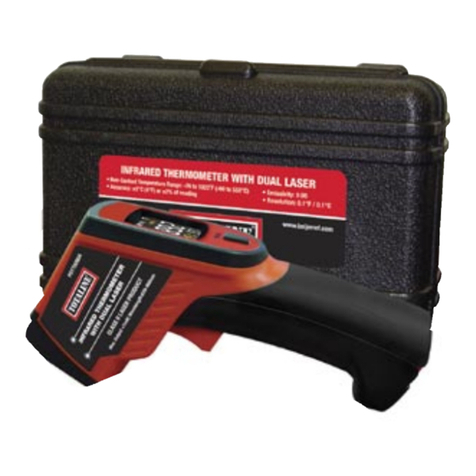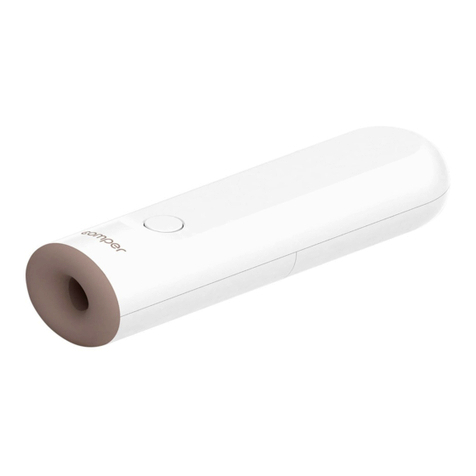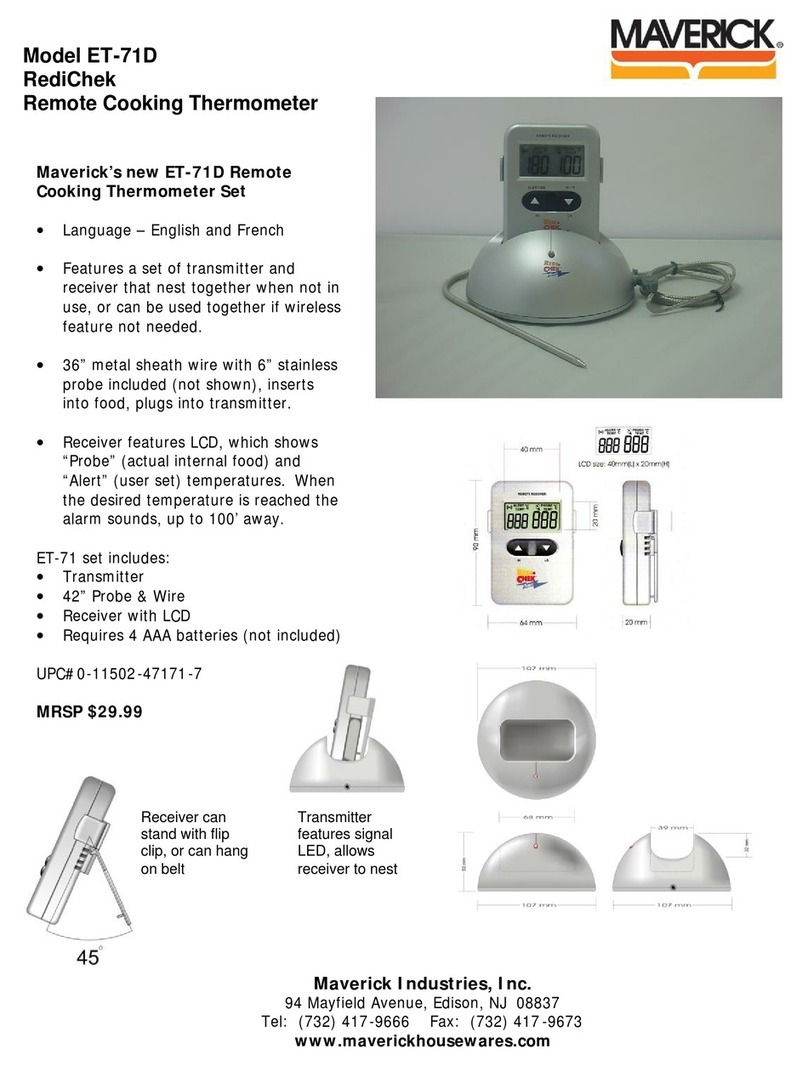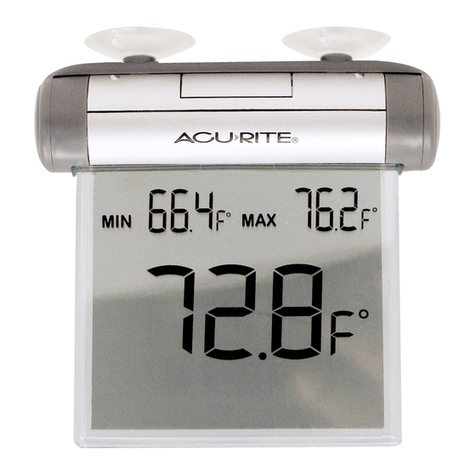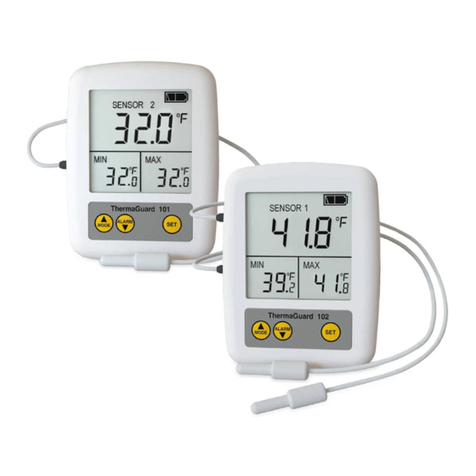MESSKO MTeC EPT202 User manual


Operating Instructions BA 2076/02/01
www.messko.de MTeC®- EPT20EPT20
EPT20EPT20
EPT2022
22
2 Digital ThermometerDigital Thermometer
Digital ThermometerDigital Thermometer
Digital Thermometer
MesskoMessko
MesskoMessko
Messko

2BA 2076/02/01

3
BA 2076/02/01
11
11
1GenerGener
GenerGener
Generalal
alal
al ......................................................................................................................................................................................................................................................................................................................................................................
......................................................................................................................................................................................................................................................................................................................................................................
................................................................................................................................................................................... 55
55
5
1.1 Safety Instructions ...................................................................................................................................................................... 5
1.2 Use as Specified ........................................................................................................................................................................... 5
1.3 Notes on the Operation of the Device ................................................................................................................................... 5
1.4 Design ............................................................................................................................................................................................ 5
1.5 Capacity Features of the Basic Device ................................................................................................................................... 6
22
22
2Technical DataTechnical Data
Technical DataTechnical Data
Technical Data ..............................................................................................................................................................................................................................................................................................................................................
..............................................................................................................................................................................................................................................................................................................................................
....................................................................................................................................................................... 66
66
6
33
33
3MountingMounting
MountingMounting
Mounting ..............................................................................................................................................................................................................................................................................................................................................................
..............................................................................................................................................................................................................................................................................................................................................................
............................................................................................................................................................................... 99
99
9
3.1 EPT202 for Rail Mounting ......................................................................................................................................................... 9
3.2 EPT202 as 19" Rack .................................................................................................................................................................... 9
3.3 EPT202 for Control Panel Mounting ...................................................................................................................................... 9
3.4 EPT202 for Installation in the Motor Drive ED of the MR On-Load Tap-Changer ................................................... 10
44
44
4Electrical connectionElectrical connection
Electrical connectionElectrical connection
Electrical connection....................................................................................................................................................................................................................................................................................................................
....................................................................................................................................................................................................................................................................................................................
.......................................................................................................................................................... 1010
1010
10
4.1 Supply Voltage ........................................................................................................................................................................... 10
4.2 Sensor Inputs .............................................................................................................................................................................. 10
4.3 CT Input (Secondary Current Transformer) ......................................................................................................................... 11
4.4 Analog Outputs .......................................................................................................................................................................... 11
4.5 Digital Interfaces ....................................................................................................................................................................... 11
4.6 Switching Contacts ................................................................................................................................................................... 12
55
55
5Function DescriptionFunction Description
Function DescriptionFunction Description
Function Description....................................................................................................................................................................................................................................................................................................................
....................................................................................................................................................................................................................................................................................................................
.......................................................................................................................................................... 1313
1313
13
5.1 Basic Function ........................................................................................................................................................................... 13
5.2 Sensor Inputs .............................................................................................................................................................................. 13
5.3 Analog Outputs ..........................................................................................................................................................................13
5.4 Device Self-Monitoring ...........................................................................................................................................................13
5.5 Switching contacts S1…S4 ..................................................................................................................................................... 13
5.6 Cooling-Phase-Specific Parameter Records ...................................................................................................................... 13
5.7 Load Change Operation ........................................................................................................................................................... 14
5.8 Switching contacts ALARM and TRIP ................................................................................................................................... 14
5.9 Calculation of Life Consumption ..........................................................................................................................................14
5.10 Datalogging ................................................................................................................................................................................ 15
5.11 Masking out the Winding Temperature .............................................................................................................................. 15
66
66
6OperationOperation
OperationOperation
Operation ..........................................................................................................................................................................................................................................................................................................................................................
..........................................................................................................................................................................................................................................................................................................................................................
............................................................................................................................................................................. 1616
1616
16
6.1 Front Plate ................................................................................................................................................................................... 16
6.2 Menu Prompting ....................................................................................................................................................................... 16
Table of Contents

4BA 2076/02/01
Keep for future reference!
NONO
NONO
NOTETE
TETE
TE
The information in these operating instructions may differ
from the actually delivered device.
Subject to change without prior notice.
77
77
7Indication and PIndication and P
Indication and PIndication and P
Indication and Parar
arar
arameterizationameterization
ameterizationameterization
ameterization ..........................................................................................................................................................................................................................................................................
..........................................................................................................................................................................................................................................................................
..................................................................................................................................... 1818
1818
18
7.1 Input and Output Configuration........................................................................................................................................... 18
7.2 Winding Specification Parameters ....................................................................................................................................... 18
7.3 Switching Contacts ................................................................................................................................................................... 19
7.4 <MANUFACTURER> Menu ....................................................................................................................................................... 20
7.5 <OPERATOR> Menu .................................................................................................................................................................. 20
7.6 <USER> Menu ............................................................................................................................................................................. 20
7.7 <DATA-LOGGING> Menu ......................................................................................................................................................... 21
7.8 <LIFE-CONSUM.> Menu ........................................................................................................................................................... 21
7.9 <PEAK-VALUES> Menu ............................................................................................................................................................ 22
88
88
8Visualization SoftwareVisualization Software
Visualization SoftwareVisualization Software
Visualization Software ..............................................................................................................................................................................................................................................................................................................
..............................................................................................................................................................................................................................................................................................................
....................................................................................................................................................... 2323
2323
23
8.1 Installation .................................................................................................................................................................................. 23
8.2 Design of the Software ............................................................................................................................................................ 24
8.3 The EPT202 Monitor ................................................................................................................................................................. 25
8.4 Menu Bar ..................................................................................................................................................................................... 25
8.5 <Settings> Menu ....................................................................................................................................................................... 26
8.6 <Parameter> Menu ................................................................................................................................................................... 27
8.7 The Print Assistant ..................................................................................................................................................................... 27
8.8 <User> Menu .............................................................................................................................................................................. 28
8.9 <Switching Points> Menu ...................................................................................................................................................... 34
8.10 <Winding> Menu ...................................................................................................................................................................... 35
8.11 Easy Set Function ...................................................................................................................................................................... 36
8.12 <Device data> Menu ................................................................................................................................................................ 37
99
99
9AppendixAppendix
AppendixAppendix
Appendix ............................................................................................................................................................................................................................................................................................................................................................
............................................................................................................................................................................................................................................................................................................................................................
.............................................................................................................................................................................. 3838
3838
38
9.1 Dimension Drawing of the EPT202 for Rail Mounting ................................................................................................... 38
9.2 Dimension Drawing of EPT202 for 19" Rack ..................................................................................................................... 39
9.3 Dimension Drawing of EPT202 for Control Panel Mounting ........................................................................................ 40
9.4 Dimension Drawing of EPT202 for Installation in Motor Drive ED of the MR On-Load Tap-Changer ............... 41
9.5 Connection Diagram of the EPT202 for Top-Hat Rail Mounting ................................................................................. 42
9.6 Connection Diagram of the EPT202 for Control Panel Installation and 19" Subrack ........................................... 43
9.7 Circuit Diagram for 4 to 20 mA Sensor Connection ........................................................................................................ 44
9.8 Circuit Diagram for Pt100 Sensor Connection ................................................................................................................. 45
Table of Contents

5
BA 2076/02/01
1 General
11
11
1GenerGener
GenerGener
Generalal
alal
al
1.1.1.1.
1.1.1.1.
1.1. Safety InstructionsSafety Instructions
Safety InstructionsSafety Instructions
Safety Instructions
All personnel involved in installation, commissioning,
operation, maintenance or repair of the equipment must
· be suitably qualified and
· strictly observe these operating instructions.
Improper operation or misuse can lead to
· serious or fatal injury,
· damage to the equipment and property of the operator
and
· a reduction in the efficiency of the equipment.
Safety instructions in this manual are presented in three
different forms to emphasize important information.
WARNINGWARNING
WARNINGWARNING
WARNING
This information indicates particular danger to life and
health. Disregarding such warnings can lead to serious or
fatal injury.
1.21.2
1.21.2
1.2 Use as SpecifiedUse as Specified
Use as SpecifiedUse as Specified
Use as Specified
Together with a temperature sensor, the EPT202 device from
the MTeC® series indicates the oil and winding temperature
of oil-insulated transformers, reactors or on-load
tap-changers. The device can be used to control the individu-
al cooling stages based on load and temperature and, in
emergencies, shut down the entire transformer.
Before commissioning the device, it is essential to read and
adhere to the limit values for the application specified on the
nameplate and operating instructions.
1.31.3
1.31.3
1.3 Notes on the Operation of the DeviceNotes on the Operation of the Device
Notes on the Operation of the DeviceNotes on the Operation of the Device
Notes on the Operation of the Device
User adherence to national accident prevention regulations is
mandatory.
It is also pointed out that work on active (i.e., parts which are
hazardous to touch) is only permitted when these parts are
potential free or are protected against direct touch.
National regulations pertaining to electrical installation must
be observed. To ensure correct operation, it is essential to
connect the protective conductor (PE).
1.41.4
1.41.4
1.4 DesignDesign
DesignDesign
Design
The device is available in 4 models.
- Compact device in an aluminum housing for installation on
a rail in accordance with EN 60 715 TH 35-7.5 and
TH 35-15
- 19" Rack (3 HE, 42 TE, depth: 176 mm) for insertion in a
19" cabinet system
- Device for control panel installation with panel cutout,
236 mm x 142 mm
- 19" subrack for installation in the motor drive ED of the
MR on-load tap-changer
The electrical connection is performed with plug-in
connectors in accordance with DIN 41 612. An SPI interface
is available on the side of the device for the connection of
extra modules (OL/CT).
NOTENOTE
NOTENOTE
NOTE
These notes provide important information on a certain
topic.
CAUTIONCAUTION
CAUTIONCAUTION
CAUTION
This information indicates particular danger to the
equipment or other property of the operator, risk of
serious or fatal injury.
CAUTIONCAUTION
CAUTIONCAUTION
CAUTION
Make sure that all power supplies leading to the digital
thermometer are disconnected at the switchgear cubicle
before doing impulse voltage testing or any other kind of
applied voltage testing to the transformer.
NOTENOTE
NOTENOTE
NOTE
When using the additional modules EPT202OL, EPT202CT or
EPT202OL/CT, please refer to the operating instructions
BA2078.

6BA 2076/02/01
2 Technical Data
An Easy-Set function is also available with the visualization
software with which the parameterization can be performed
in accordance with the IEC standard.
Four relays are used to control 5 cooling stages. These can
also be selectively controlled during load changing operation.
This permits a time-equalized load of the individual cooling
stages. In addition one relay each is available for Alarm and
Trip. The switching point, the hysteresis and the delay time of
the individual relays can be set as desired and they can be
addressed via the oil or winding temperature. Manual
operation is also possible as an alternative.
A further special feature is the life management calculation
in accordance with the IEC or ANSI standard.
A temperature sensor can be connected to the 4-20mA sensor
input to record the ambient temperature. A Pt100 sensor must
then be used to detect the Top-Oil temperature.
1.51.5
1.51.5
1.5 Capacity FeaturCapacity Featur
Capacity FeaturCapacity Featur
Capacity Features of the Basic Devicees of the Basic Device
es of the Basic Devicees of the Basic Device
es of the Basic Device
The basic device indicates one oil and winding temperature
each on an LCD display. This requires the connection to the
device of a temperature sensor with Pt100 or 4…20mA
output which measures the „TopOil“ temperature in the
transformer. The minimum and maximum values of the oil
and winding temperature as well as the maximum value of
the load current are indicated and can be called later. Two
analog outputs and one RS 485 interface are available for
remote indication of the temperature values.
The data logging function is used to store the temperature-
specific data on the device at regular intervals so that it can
be called at all times.
The thermal image of the transformer is simulated in
accordance with IEC 60354 or ANSI standard. For this the CT
current which indicates the load of the transformer must be
connected to the device. Parameterization of the transformer
and cooling stage can be performed via the keys on the front
or via visualization software which is available as an option.
22
22
2Technical DataTechnical Data
Technical DataTechnical Data
Technical Data
Protective housingProtective housing
Protective housingProtective housing
Protective housing
Rail mounting:
Aluminum housing, can be snapped on for carrying rail in accordance with DIN EN 60715 TH 35-7.5
and TH 35-15, protection rating: IP 00 in accordance with IEC 60529, weight: approx. 1.2 kg
19" Subrack 42TE: 19" rack in accordance with DIN 41494, part 5, 223 x 133 x 178 mm (W x H x D) for installation in
19" cabinet system, protection rating: IP 00 in accordance with IEC 60529, weight: approx. 1.5 kg
Control panel mounting: Aluminum housing, 270 x 200 x 133 mm (W x H x D) for panel cutout 236 x 142 mm (W x H),
protection rating: IP 00 in accordance with IEC 60529, weight: approx. 1.5 kg
19" Subrack 84TE: 19" rack in accordance with DIN 41494, part 5, 483 x 133 x 178 mm (W x H x D),
protection rating: IP 00 in accordance with IEC 60529, weight: approx. 2.5 kg
Temperature rangeTemperature range
Temperature rangeTemperature range
Temperature range
Operation: -25°C ... +70°C
Storage: -30°C ... +85°C
Operator elements, indication, terminalsOperator elements, indication, terminals
Operator elements, indication, terminalsOperator elements, indication, terminals
Operator elements, indication, terminals
Operator elements: 5 function buttons with perceptible pressure point
Indication: Monochrome display, white letters on blue backlight, 128 x 64 pixels
Status LEDs: 1 LED, green, for „POWER“ operational indication
1 LED, yellow, for „ALARM“ switching contact
1 LED, red, for „TRIP“ switching contact
1 LED, red, for „ERROR“ switching contact
4 LEDs, yellow, for switching contacts S1, S2, S3 and S4
Terminals: Safety screw terminals, for rigid braided leads: 0.2 - 2.5 mm2, AWG 24 - 12,
flexible braided leads (with core end sleeves): 0.2 - 2.5 mm2, AWG 24 - 12

7
BA 2076/02/01
2 Technical Data
InputsInputs
InputsInputs
Inputs
Supply voltage: 100 to 240 V AC, 50 to 400 Hz
100 to 353 V DC
optional: 20-72VDC
Power consumption: Max. of 10 VA or 10 W
Temperature sensor: Pt100 signal in accordance with IEC 751 in 2 or 3-conductor technology or 4 to 20 mA signal (active
or passive), standard measuring range: -20 °C to +140 °C (others on request)
Measuring converters can be provided for other input signals e.g. 0 to 1 mA or 0 to 10 V.
Optional: The 4-20mA input can be used to record the ambient temperature (active or passive
signal), the standard measuring range is -40 to +120°C.
Current transformer input: 0.5 to 5 A CT rated current
Continuous load capacity: 10 A for 8 hours
Short-time current: 500 A for 1 second
Optional: Design including a split core current transformer for cable diameters up to max. Ø10
OutputsOutputs
OutputsOutputs
Outputs
Analog outputs: 1 oil temperature, temperature range: -20 °C to +140 °C
1 winding temperature, temperature range: 0 °C to 160 °C
Both analog outputs can be set as desired to: 0 to 10 V
0 to 1 mA
4 to 20 mA (error signal < 3.6 mA)
4 to 20 mA (error signal > 22 mA)
0 to 20 mA (error signal > 22 mA)
Interfaces: 1 RS 232 on 9-pin, sub D plug for parameterization and data logging via PC
1 RS 485 on screw terminals
1 SPI bus on 15-pin, sub D plug for connection of additional modules (for DIN rail mounting only)
Relays: 4 c/o contacts for switching points S1 to S4, contact capacity AC: 250 V / 12A, DC: 110V / 0.4 A
2 c/o contacts for ALARM and TRIP, contact capacity AC: 250 V / 5A, DC: 110V / 0.4 A 1 n/c
contact for ERROR message, contact capacity AC: 250 V / 5A, DC: 110V / 0.4 A
TestsTests
TestsTests
Tests
Electrical safety: Protection class 1 in accordance with IEC 60536
Protection rating IP00 in accordance with IEC 60529
Degree of soiling 2 in accordance with IEC report 664-1
Overvoltage category III in accordance with IEC report 664-1
Electromagnetic compatibility:
IEC 61000-4-2 Interference immunity against electrostatic discharge with 6/8 kV
IEC 61000-4-3 Interference immunity against HF fields with 10 V/m, 80 to 1000 MHz
IEC 61000-4-4 Interference immunity against bursts with 2 kV
IEC 61000-4-5 Interference immunity against surges with 2 kV
IEC 61000-4-6 Interference immunity against HF on lines with 10 V, 150 kHz to 80 MHz
IEC 61000-4-8 Interference immunity against magnetic fields with 30 A/m, 50 Hz, continuous
IEC 61000-4-11
Interference immunity against voltage drops with AC supply: 30 % / 0.5 period
60 % / 5 periods; with DC supply 100 % / 10 ms and 60 % / 100 ms
EN 61000-6-2 CE conformity
EN 61000-6-4 CE conformity
Temperature and climate resistance:
IEC 60068-2-1 Dry cold, -25 °C/20 hours
IEC 60068-2-2 Dry heat, +70°C / 16 hours
IEC 60068-2-3 Moist heat, constant, +40°C/93 % / 2 days, no moisture condensation
IEC 60068-2-30 Moist heat, cyclic (12 x 12 hours) + 55°C / 93 % / 6 cycles

8BA 2076/02/01
Setting rangesSetting ranges
Setting rangesSetting ranges
Setting ranges
ParameterParameter
ParameterParameter
Parameter RemarksRemarks
RemarksRemarks
Remarks Step SizeStep Size
Step SizeStep Size
Step Size
Temperature range, analog output 1 Calibration at plant: -20 to +140 °C 1 °C
(specifies the range of sensor input (others on request)
and analog output 1)
Temperature range analog output 2 Calibration at plant: 0 to +160 °C 1 °C
(others on request)
Data logging interval 5 to 1440 min. 1 min.
Test function 0 to 150% of temperatur range 0.1 °C
(standard -20 to +220 °C)
Zero point correction ± 10 % of temperature range 0.1 K
(standard -16.0 to 16.0 K)
RS 485 address 0 to 79
Load change interval 0 to 9999 h 1 h
Switching points S1 to S4 Adjustable between 0.1 °C
hysteresis and 150% of
temperature range
Hystereses S1 to S4 Min. of 1% of temperature range 0.1 K
Delay times S1 to S4 0 to 120 sec. 0.1 sec.
Switching points ALARM, TRIP Adjustable between 0.1 °C
hysteresis and 150% of
temperature range
Hystereses ALARM, TRIP Min. of 1% of temperature range 0.1 K
Delay times ALARM, TRIP 0 to 120 sec. 0.1 sec.
CT transformer ratio 1 to 5000:1 1
Hotspot factor (H) 1.0 to 2.0 0.1
CT rated current 0.50 to 5.00 A 0.01A
Gradient (gr) 0.0 to 50.0 K 0.1 K
Winding exponent 1.0 to 2.0 0.1
Time constant 0 to 30 min. 1 min.
2 Technical Data

9
BA 2076/02/01
3 Mounting
33
33
3MountingMounting
MountingMounting
Mounting
3.13.1
3.13.1
3.1 EPT202 for Rail MountingEPT202 for Rail Mounting
EPT202 for Rail MountingEPT202 for Rail Mounting
EPT202 for Rail Mounting
The EPT202 (see Fig. 1) is designed for mounting on a rail in
accordance with EN 60715 TH 35-7.5 or TH 35-15. To install,
the device must be placed on the rail with the mounting
clamps and pressed down until the device snaps in onto the
rail. For the dimensions, see the appendix (chap. 9.1).
3.23.2
3.23.2
3.2 EPT202 as 19" subrack 42TEEPT202 as 19" subrack 42TE
EPT202 as 19" subrack 42TEEPT202 as 19" subrack 42TE
EPT202 as 19" subrack 42TE
The standardized rack of the EPT202 is designed for
installation in a 19" cabinet system. Slide the subrack into the
cabinet system and secure it using the bore holes on the front
(see appendix, chap. 9.2).
Fig. 1
3.33.3
3.33.3
3.3 EPT202 for Control Panel MountingEPT202 for Control Panel Mounting
EPT202 for Control Panel MountingEPT202 for Control Panel Mounting
EPT202 for Control Panel Mounting
A panel cutout must be provided in the switching cabinet for
the installation of the EPT202. For dimensions, see appendix,
chap. 9.3. Slide the device into the cutout and secure with
the help of the bored holes on the front.
Fig. 3Fig. 2
CAUTIONCAUTION
CAUTIONCAUTION
CAUTION
The device may only be mounted, electrically connected
and commissioned by qualified, trained personnel as
specified by these operating instructions.
The user must ensure that the device is used for its
intended purpose.
Arbitrary and incorrect work which is performed without
previously consulting Messko is forbidden for safety
reasons!

10 BA 2076/02/01
3.43.4
3.43.4
3.4 EPT202 for subrack 84TEEPT202 for subrack 84TE
EPT202 for subrack 84TEEPT202 for subrack 84TE
EPT202 for subrack 84TE
A 19“ subrack of double width (84TE) is available for
integration into the motor drive ED of a MR on-load tap-
changer or any other switching cabinet application.
Installation is the same as previously described for the 19“
subrack in chapter 3.2. Please refer to the appendix for all
relevant dimensions.
44
44
4Electrical ConnectionElectrical Connection
Electrical ConnectionElectrical Connection
Electrical Connection
The EPT202 must be connected as shown in the device-
specific connection diagrams in the appendix (see chap. 9.5
to 9.7). The individual connections will now be described in
more detail below. The numbering of the terminals is deviating
between the EPT202 for rail mounting and the EPT202 for
panel mounting or 19“ rack. The numbering for panel
mounting and 19“ rack is given in brackets in the following
describtion
WARNINGWARNING
WARNINGWARNING
WARNING
Make sure that the electrical connection of the EPT202
and particularly the grounding is performed carefully.
Otherwise there is a danger to life!
Do not switch on the supply voltage until the electrical
connection has been made correctly.
POWER
TRIP
ERROR
ALARM
Messko
S 1
S 3
S 4
S 2
Fig. 4
44
44
4Electrical ConnectionElectrical Connection
Electrical ConnectionElectrical Connection
Electrical Connection
NOTENOTE
NOTENOTE
NOTE
The EPT202 was developed in accordance with applicable
EMC standards. To maintain the EMC characteristics, the
following points must be adhered to.
•Ensure that the EPT202 is properly grounded via the
grounding connection on the device.
•Use the shielded cables for the data and signal
connection from the EPT202 to other devices. Ground the
shield to the terminals provided for this purpose.
4.14.1
4.14.1
4.1 Supply VSupply V
Supply VSupply V
Supply Voltageoltage
oltageoltage
oltage
The EPT202 is equipped with a wide-range
input: 100 to 240 V AC or 100 to
353 V DC. Connect the supply voltage to
terminals 22 (42) L and 23 (41) N and the
grounding to terminal 21 (43) PE.
4.24.2
4.24.2
4.2 Sensor InputsSensor Inputs
Sensor InputsSensor Inputs
Sensor Inputs
The EPT202 can be operated with either a Pt100 or a 4-20mA
temperature sensor. In case, the ambient temperature is to be
recorded as well, a 4-20MA sensor must be used.
Measurement of the Top-Oil temperature is then achieved by
means of a Pt100 sensor.
4.2.14.2.1
4.2.14.2.1
4.2.1 Pt100-Signal (RTD) using 2 or 3 conductor wirePt100-Signal (RTD) using 2 or 3 conductor wire
Pt100-Signal (RTD) using 2 or 3 conductor wirePt100-Signal (RTD) using 2 or 3 conductor wire
Pt100-Signal (RTD) using 2 or 3 conductor wire
technologytechnology
technologytechnology
technology
Sensor connection: Terminals 9 and 10
Equalizing line: Terminal 8
Shield: Terminal 7
Caution:Caution:
Caution:Caution:
Caution: When using 2-conductor wire
technology, terminals 8 and 9 must be
jumpered!
Input Pt100
1098
7

11
BA 2076/02/01
4 Electrical connection
4.2.24.2.2
4.2.24.2.2
4.2.2 4 to 20 mA active Sensor I4 to 20 mA active Sensor I
4 to 20 mA active Sensor I4 to 20 mA active Sensor I
4 to 20 mA active Sensor I11
11
1
Input I1
has an internal voltage supply for a sensor with
4 to 20 mA output and no ownno own
no ownno own
no own voltage supply
(e.g., MT-ST160SK/TT)
Sensor connection (+): Terminal 12
Sensor connection (-): Terminal 13
Shield: Terminal 11
Caution:Caution:
Caution:Caution:
Caution: Adhere to the maximum load of
the sensor and the circuiting.
4.2.34.2.3
4.2.34.2.3
4.2.3 4 to 20 mA passive Sensor I4 to 20 mA passive Sensor I
4 to 20 mA passive Sensor I4 to 20 mA passive Sensor I
4 to 20 mA passive Sensor I22
22
2
Input I2 is designed for a sensor with 4 to 20 mA output and
its ownown
ownown
own voltage supply (e.g., TT-PWM60).
Sensor connection (+): Terminal 13 (8),
Sensor connection (-): Terminal 14 (7),
Shield: Terminal 11 (10)
Supply voltage: 24 VDC ± 10%
Caution:Caution:
Caution:Caution:
Caution: Adhere to the maximum load of
the sensor and the circuiting.
4.44.4
4.44.4
4.4 Analog OutputsAnalog Outputs
Analog OutputsAnalog Outputs
Analog Outputs
The analog outputs for oil and winding temperature can be
parameterized as desired to the following values.
•0 to 10 V
•0 to 1 mA
•4 to 20 mA (error signal < 3.6 mA)
•4 to 20 mA (error signal > 22 mA)
•0 to 20 mA (error signal > 22 mA)
The error signal is output on the analog output when the
input sensor is defective.
With the current outputs, the maximum load (total resistance
of the lines and connected devices) of 750 Wmay not be
exceeded. The internal voltage supply is 24 V DC +10%. When
a current output is not used, its terminals (+) and (-) must be
jumpered. Otherwise an error message is output.
When an analog output is parameterized to 0 - 10 V, this
must be loaded with at least 1 kW. The voltage output may not
be jumpered. An open or defective voltage output is not
detected.
Analog output 1 “Output Oil-TAnalog output 1 “Output Oil-T
Analog output 1 “Output Oil-TAnalog output 1 “Output Oil-T
Analog output 1 “Output Oil-Temp“emp“
emp“emp“
emp“
Line connection (+): Terminal 2
Line connection (-): Terminal 3
Shield: Terminal 1
The range of analog output 1 corresponds
to the input range of the sensor (refer to
nameplate), standard: -20 to +140 °C.
Example: 4 to 20 mA output:
4 mA corresponds to -20 °C
20 mA corresponds to +140 °C
Analog output 2 “Output Winding“Analog output 2 “Output Winding“
Analog output 2 “Output Winding“Analog output 2 “Output Winding“
Analog output 2 “Output Winding“
Line connection (+): Terminal 5
Line connection (-): Terminal 6
Shield: Terminal 4
The range of analog output 2 is specified
on the nameplate (standard: 0 to +160 °C).
Example: 4 to 20 mA output:
4 mA corresponds to 0 °C
20 mA corresponds to +160 °C
4.54.5
4.54.5
4.5 Digital interfacesDigital interfaces
Digital interfacesDigital interfaces
Digital interfaces
To be able to parameterize the EPT202 with the visualization
software and call up the data, the EPT202 must be connected
via an interface with a PC. The following interfaces are
available for this purpose.
•RS 232
•RS 485 (bus-capability)
Input 4...20mA
14
13
1211
I1
+I2
+
Output
Winding
+-
65
4
Output
Oil Temp.
+-
321
Input 4...20mA
14131211
I1
+I2
+
RS 232RS 232
RS 232RS 232
RS 232
To transmit data between a PC and the EPT202 via the RS
232 interface, connect the RS 232 interface of the PC (or an
interface converter) with a suitable 9-pin connection cable to
the sub D plug connector on the front of the device.
WARNINGWARNING
WARNINGWARNING
WARNING
High voltage, when the CT lines are disconnected and the
transformer is operating.
4.34.3
4.34.3
4.3 CT Input (Secondary CurrCT Input (Secondary Curr
CT Input (Secondary CurrCT Input (Secondary Curr
CT Input (Secondary Current Tent T
ent Tent T
ent Trr
rr
ransformer)ansformer)
ansformer)ansformer)
ansformer)
Connect the lines of the CT transformer to
terminals 15 and 16.
If the EPT202 is equipped with a split core
transformer, then it must also be connected
to terminals 15 and 16.
This input can be deactivated during
parameter assignment so that only the oil
temperature is indicated, for example.
CT
15 16

12 BA 2076/02/01
4 Electrical connection
RS485RS485
RS485RS485
RS485
Data line A: Terminal 19 (2)
Data line B: Terminal 20 (1)
Ground connection: Terminal 18 (3)
Shield: Terminal 17 (4)
The RS 485 interface can be used to set up
a subsystem as shown in Fig. 4 with a
maximum of 32 devices.
The RS 485 interface uses a separate
company protocol. The description and
additional protocols are available on
request.
RS485
GND
A(+)
B(-)
20191817 Switching contacts ALARM and TRIPSwitching contacts ALARM and TRIP
Switching contacts ALARM and TRIPSwitching contacts ALARM and TRIP
Switching contacts ALARM and TRIP
These two switching contacts can be used
to generate an alarm message or trip the
transformer.
Connect the two relay contacts as required
for the application.
Error
42 43
Alarm
383736
ERROR contactERROR contact
ERROR contactERROR contact
ERROR contact
The ERROR contact is switched by the
internal self-monitoring function of the
device. (See chap. 5.4.)
When the device is in operation and there
is no device error, the contact is open
between terminals 42 (21)and 43 (22).
When there is a device error, the contact is
closed (fail-safe programming).
This contact can be used to generate an error message for
remote transmission. For a description of the self-monitoring
function of the device, see chapter 5.4.
4.64.6
4.64.6
4.6 Switching ContactsSwitching Contacts
Switching ContactsSwitching Contacts
Switching Contacts
Switching contacts S1 to S4Switching contacts S1 to S4
Switching contacts S1 to S4Switching contacts S1 to S4
Switching contacts S1 to S4
The switching contacts S1 to S4 can be
used to switch on or off the individual
cooling stages of a transformer based on
the temperature.
Connect the lines of the fans/pumps to the
relay contacts for this.
S1
262524
Parallel to the contacts, the EPT202 switches the cooling-
phase-specific winding parameters (for more details, see
chapter 5). This must be considered when connecting the
relays.
Fig. 5
GND A B
17 18 19 20
EPT202
RS485 address 2
120 Ohm
EPT202
RS485 address 32
17 18 19 20
GND A B
Konverter
RS485 / RS232
Schnittstellen
24VDC
RS232
RS485
RS485
120 Ohm
GND A B
17 18 19 20
EPT202
RS485 address 1
Interface converter
RS485 / RS232

13
BA 2076/02/01
55
55
5Function DescriptionFunction Description
Function DescriptionFunction Description
Function Description
5.15.1
5.15.1
5.1 Basic FunctionBasic Function
Basic FunctionBasic Function
Basic Function
The EPT202 is used to measure the temperature of
transformers or similar devices. The oil temperature is fed in to
the EPT202 via a temperature sensor. Internally the EPT202
calculates the thermal image (Hotspot temperature) in acc.
with IEC 354 or ANSI standard and indicates the oil and
winding temperature on its display.
The winding temperature (Hotspot) is calculated acc. to the
following equations:
Calculation acc. to IEC 354:
Calculation acc. to ANSI IEEE Std. C57.91:1995
Whereby: : Hotspot temperature
: Top-Oil temperature
: Hotspot factor
: Gradient of the average winding
temperature over average oil
temperature at rated current
: Gradient of the Hotspot temperature
over the Top-Oil temperature at rated
load
: Load factor (actual current / rated
current)
: Winding exponent
: Exponent for the calculation of the
actual Hotspot temperature
: Time constant of oil
If the calculation is to be done according to ANSI standards, a
Hotspot factor of 1,0 must be used and instead of the winding
exponent the appropriate ASNI exponent (2m) must be put in
to the equation.
5.45.4
5.45.4
5.4 Device Self-MonitoringDevice Self-Monitoring
Device Self-MonitoringDevice Self-Monitoring
Device Self-Monitoring
The EPT202 continuously monitors itself. The following errors
are detected by the device.
•Defective sensor
•Analog output 1 (oil temperature) open
•Analog output 2 (winding temperature) open
•Error of the supply voltage
When one of these errors has been detected, the ERROR
contact is closed, the ERROR LED goes on, the error is
indicated on the display and in the visualization software, and
the analog outputs (if current output) indicate the error signal.
CAUTIONCAUTION
CAUTIONCAUTION
CAUTION
When the device detects the error „sensor defective“ or an
error of the supply voltage, the switching contacts S1 to
S4 are closed and the ALARM and TRIP contacts retain
their current status.
5.55.5
5.55.5
5.5 Switching Contacts S1 to S4Switching Contacts S1 to S4
Switching Contacts S1 to S4Switching Contacts S1 to S4
Switching Contacts S1 to S4
The EPT202 is equipped with 4 relay contacts to activate fans
or pumps. These contacts can be turned on and off via the oil
or the winding temperature or, as an alternative, can be
turned permanently on by hand. The hysteresis and the delay
time of the contacts can be parameterized as desired.
The switching contacts S1 to S4 also switch the cooling-
phase-specific winding parameters.
5.65.6
5.65.6
5.6 Cooling-Phase-Specific Parameter RecordsCooling-Phase-Specific Parameter Records
Cooling-Phase-Specific Parameter RecordsCooling-Phase-Specific Parameter Records
Cooling-Phase-Specific Parameter Records
The winding parameters for 5 different cooling stages can be
stored on the EPT202 with the following values.
• Rated CT current
•Gradient gr
•Winding exponent y
•Winding time constant t
5 Function Description
⎟
⎟
⎠
⎞
⎜
⎜
⎝
⎛−×××+= −
τ
t
y
rOilTopSpotHot eKgHθ(t)θ1
⎟
⎟
⎠
⎞
⎜
⎜
⎝
⎛−××+= −
τ
t
m
H,ROilTopSpotHot eK∆θθ(t)θ1
2
TopOil
θ
H
(t)θSpotHot
r
g
RH
θ,
∆
K
y
m
τ
5.25.2
5.25.2
5.2 Sensor InputsSensor Inputs
Sensor InputsSensor Inputs
Sensor Inputs
A Pt100 sensor or a sensor with an active or passive
4 to 20 mA output signal can be used as an input sensor. The
sensor type (Pt100 or 4 to 20 mA) must be parameterized by
the user.
Through the use of an optional 4 to 20mA sensor, the EPT202
can record and store the ambient temperature by means of a
data logging function. The Top-Oil temperature must then be
detected by a Pt100 sensor.
The temperature range of the oil temperature sensor input is
set to -20 to +140 °C (standard). Other temperature ranges are
also available on request. The temperature range is also used
to indicate the event of a defect sensor, which happens when
the temperature exceeds or drops below the admissible range.
When a sensor with 4 to 20 mA output signal is used, the
measuring range of the sensor output must comply to the
temperature range of the EPT202. Please check the nameplate
information.
5.3 Analog Outputs5.3 Analog Outputs
5.3 Analog Outputs5.3 Analog Outputs
5.3 Analog Outputs
The basic device is equipped with one analog output each for
transmission of the oil temperature and the winding
temperature. The output signal can be parameterized. The
following output signals can be set as standard.
•0 to 20 mA (error signal > 22 mA)
•4 to 20 mA (error signal > 22 mA)
•4 to 20 mA (error signal < 3.6 mA)
•0 to 1 mA
•0 to 10 V
Additional output signals can be implemented with a signal
converter. The error signal is output when a defective sensor
or an open analog output is detected.

14 BA 2076/02/01
When cooling stage ONAF1 was active for another 100 hours,
the relays are then changed again.
The same principle applies when 3 or 4 cooling stages are
assigned to load change operation.
5.85.8
5.85.8
5.8 Switching Contacts ALARM and TRIPSwitching Contacts ALARM and TRIP
Switching Contacts ALARM and TRIPSwitching Contacts ALARM and TRIP
Switching Contacts ALARM and TRIP
The EPT202 is equipped with 2 additional switching contacts
to generate an alarm message and to trip the transformer. By
assigning parameters, these contacts can be assigned to the
oil or the winding temperature and the hysteresis and delay
time can be set.
5.95.9
5.95.9
5.9 Calculation of Life ConsumptionCalculation of Life Consumption
Calculation of Life ConsumptionCalculation of Life Consumption
Calculation of Life Consumption
The life consumption calculation can be configured with 2
algorithms (calculation as per ANSI or as per IEC standard) or
can be masked out.
Both algorithms are a function of the hotspot temperature.
The calculation can only supply a realistic value when the
winding parameters are assigned correctly.
Both algorithms supply the life consumption as a percentage
of the expected lifespan. The expected lifespan must be
parameterized for this.
NONO
NONO
NOTETE
TETE
TE
The expected lifespan for the insulation system of a
transformer winding depends on the materials used and
the construction.
This value can be obtained from the manufacturer of the
transformer.
Calculation in accordance with ANSI standardCalculation in accordance with ANSI standard
Calculation in accordance with ANSI standardCalculation in accordance with ANSI standard
Calculation in accordance with ANSI standard
C57.91-1995 (+errata)C57.91-1995 (+errata)
C57.91-1995 (+errata)C57.91-1995 (+errata)
C57.91-1995 (+errata)
Recommended for transformers whose construction is
dominated by the US American standards ANSI or IEEE.
The cooling stages are called COOLING 0 to COOLING 4 on
the EPT202. The parameter record of the last cooling stage is
always active and thus provides the basis for the calculation
of the winding temperature and life management
consumption.
The parameter records of the cooling stages are linked with
the switching contacts as shown below.
•No switching contact switched - COOLING 0 active
•Switching contact S1 switched - COOLING 1 active
•Switching contact S2 switched - COOLING 2 active
•Switching contact S3 switched - COOLING 3 active
•Switching contact S4 switched - COOLING 4 active
5.75.7
5.75.7
5.7 Load Change OperLoad Change Oper
Load Change OperLoad Change Oper
Load Change Operationation
ationation
ation
The load change function permits the fans or pumps
connected to the switching contacts to be loaded equally.
Each switching point can be individually assigned to load
change operation. During load change operation the relays of
the assigned switching contacts are switched in sequence
after the adjustable load change internal has expired. The LED
display and the winding parameters of the active cooling
stage remain as they were before.
The load change function will now be explained using the
following example.
Cooling stage 1 of a transformer is ONAF1. The left fan group
is turned on with switching point S1 and the related
parameter record of the COOLING1 cooling stage is activated.
Cooling stage 2 is ONAF2. The right fan group is switched
through with switching point S2 and the related parameter
record of the COOLING2 cooling stage is activated.
Without load change operation, the runtime of the left fan
group (active during COOLING1 and COOLING2) would be
greater than that of the right fan group (only active during
COOLING2).
Switching points S1 and S2 are now assigned to the load
change operation and a load change interval of 100 hours is
parameterized. If cooling stage ONAF1 was now active for a
total of 100 hours (the left fan group has run 100 hours
alone), switching contacts S1 and S2 then change the relays.
Switching contact S1 now switches with the actual relay of
switching contact S2 and vice versa. This turns off the left
fan group and turns on the right fan group. The status of the
LED display and the parameter record of the active cooling
stage (COOLING1 in our example) are not affected by this.
When activation is performed by switching point S2 (ONAF2
or COOLING2), then S2 switches the left fan group through
with the actual relay of S1.
5 Funktion Description
CAUTIONCAUTION
CAUTIONCAUTION
CAUTION
The calculation of life consumption of the EPT202 is based
on the thermal aging of a transformer winding in
accordance with ANSI or IEC standards. Remember that
the value calculated here may not reflect actual
conditions.
Life consumption only refers to the insulation system of a
transformer winding and not to the complete transformer.

15
BA 2076/02/01
Calculation in accordance with IEC 354,Calculation in accordance with IEC 354,
Calculation in accordance with IEC 354,Calculation in accordance with IEC 354,
Calculation in accordance with IEC 354,
second edition 1991-9second edition 1991-9
second edition 1991-9second edition 1991-9
second edition 1991-9
Recommended for transformers whose construction was
based on IEC standards.
With this calculation algorithm, the EPT202 places relative
thermal rate of aging as per IEC 354 in relation to the
expected lifespan and calculates the life consumption as a
percentage (like the ANSI standard).
5.105.10
5.105.10
5.10 Data LoggingData Logging
Data LoggingData Logging
Data Logging
The EPT202 is equipped with an internal memory in which
data are stored. The time interval between storage (data
logging) of two data records can be parameterized as desired.
In addition, data sets are also stored when the following
events occur:
• Power supply - on / off
• Test mode - activated / deactivated
• Trip - activated / deactivated
• Alarm - activated / deactivated
• Device error - activated / deactivated
• Switching contacts (S1 to S4) - activated / deactivated
• Device lock - locked / unlocked
The data memory can hold a total of approx. 32,000 data
records. At an interval of 10 minutes, this means that data
covering a period of approx. 7.5 months can be stored.
The data records can be loaded with the visualization
software and evaluated with an Excel spreadsheet. A data
record contains the following information.
•· Set no.
•Date
•Time
•Device status with status indication of the switching
contacts and all relevant device data
•Event (is usually not used)
•Error code with status indication of the individual errors
•Oil temperature
•3 winding temperatures (winding temperature 1 for basic
device, winding temperature 2 and 3 only with appropriate
extra module)
•Load current (load current 1 for basic device, load current
2 and 3 only with corresponding extra module)
•Life consumption
•Oil level of the oil conservator of the transformer tank
(only with corresponding extra module)
•Oil level of the oil conservator of the OLTC/LTC (only with
corresponding extra module)
•3 in reserve (not usually used)
5.15.1
5.15.1
5.111
11
1Masking Out the Winding TMasking Out the Winding T
Masking Out the Winding TMasking Out the Winding T
Masking Out the Winding Temperemper
emperemper
emperaturatur
aturatur
aturee
ee
e
When the EPT202 is only used to indicate the oil temperature
and to control the switching contacts via the oil temperature,
the simulation of the thermal image (winding temperature)
can be masked out with the <Winding off> function.
The following functions are then deactivated.
•CT input
•Analog output 2 (winding temperature)
•Life consumption calculation
•Parameterization of the winding parameters for the device
and the visualization software
•All menu items on the device and all setting options in the
visualization software which are related to the winding
temperature
The menu items which are masked out with this function are
marked in the short operating instructions with an
asterisk (*).
5 Function Description

16 BA 2076/02/01
6 Operation
66
66
6OperOper
OperOper
Operationation
ationation
ation
6.16.1
6.16.1
6.1 FrFr
FrFr
Front plateont plate
ont plateont plate
ont plate
The design of the front plate is the same for all 4 models (refer
to Fig. 4) whereby, the connection terminals of the EPT202 for
control panel mounting and 19" subrack assembly are at the
rear. The SPI-Bus connection is located internally.
The menus, measured values and parameters are indicated on
the 8-line LCD display.
The 5 operator keys can be used to switch between the
individual menus, change parameters and reset measured
values.
With a suitable cable, the device can be connected via the
sub D plug to a PC for parameterization or for data
transmission.
The SPI bus on the side can be used to connect extra modules
such as the CT with 2 extra CT inputs.
The status LEDs signal the following operating states.
•Green POWER LED on: Device is running.
Green POWER LED flashing: Key lock released.
•Yellow ALARM LED on: ALARM contact is tripped.
•Red TRIP LED on: TRIP contact is tripped.
•Red ERROR LED on: Device error
•Yellow LED S1 to S4 on: Specific contact S1 to S4 was
tripped and the related parameter record is activated.
6.26.2
6.26.2
6.2 Menu PrMenu Pr
Menu PrMenu Pr
Menu Promptingompting
omptingompting
ompting
The 5 operator keys can be used to indicate the set
parameters and measured values.
The parameters cannot be changed until the key lock is
released.
The entire menu structure and prompting can be found in the
included short operating instructions.
Temperature indication modeTemperature indication mode
Temperature indication modeTemperature indication mode
Temperature indication mode
When in operation the device is always in
temperature indication mode. When a
menu item is selected and no key is
pressed on the device for 30 seconds, a
change is automatically made to the
higher-level menu or to temperature
indication mode.
Messwertanzeige
OILOIL-T-TEMEMPP
6565,8,8 °°CC
WINWINDIDINGNG-T-TEMPEMP
7474,2,2 °°CC
Fig. 6
11
11
122
22
2
66
66
633
33
344
44
455
55
5
Messwertanzeige
OIL
OIL
-T
-T
EM
EM
P
P
65
65
,8
,8
°
°
C
C
WIN
WIN
DI
DI
NG
NG
-T
-T
EMP
EMP
74
74
,2
,2
°
°
C
C
Messwertanzeige
OIL
OIL
-T
-T
EM
EM
P
P
65
65
,8
,8
°
°
C
C
WIN
WIN
DI
DI
NG
NG
-T
-T
EMP
EMP
74
74
,2
,2
°
°
C
C
11
11
166
66
633
33
344
44
4
1 - Status-LED’s 4 - Operator keys
2 - Connection terminals 5 - SPI-Bus for add-on modules
3 - LCD display 6 - D-Sub-Stecker für RS232

17
BA 2076/02/01
When a device error occurs, this is
indicated in the bottom line of
temperature indication mode.
The following errors are indicated.
<Sensor Defect> Either the sensor is defective (e.g., line
break) or the wrong sensor type was
selected during parameterization.
<Oil-Analog open> The device connected to the output
<Output Oil Temp.> is defective or not
correctly connected.
When this output is not used, jumper
terminals 2 and 3.
<Wind-Analogopen>
The device connected to the output
<Output Winding> is defective or is
not wired correctly.
When this output is not used, jumper
terminals 5 and 6.
<Power Down> The supply voltage is too low. Check the
source of voltage and the wiring.
Releasing the key lock and keyReleasing the key lock and key
Releasing the key lock and keyReleasing the key lock and key
Releasing the key lock and key
code changecode change
code changecode change
code change
In the temperature indication
mode, press the keys <UP> and
<DOWN> simultaneously.
As a result, a mask opens for
key code entry. The key code
entry is made by using the 4
direction keys (factory set at
1111). When this is done
successfully, the green power LED flashes and the key lock is
released. If after 60 a period of 60seconds, no further key is
pressed, the key lock is automatically locked again.
The key code can be changed
when the key lock is unlocked.
By pressing the the keys <UP>
and <DOWN> simultaneously,
the mask <Change Key-Code>
appears, enabling a change to be made by means of the 4
direction keys and finally confirmed by pressing the <Enter>
key.
Changing to the menu levelChanging to the menu level
Changing to the menu levelChanging to the menu level
Changing to the menu level
To change from the temperature indication mode to the menu
level (jump to the main menu <PEAK VALUES>), press the
<ENTER> key.
Messwertanzeige
OIL
OIL
-T
-T
EM
EM
P
P
65
65
,8
,8
°
°
C
C
WIN
WIN
DI
DI
NG
NG
-T
-T
EMP
EMP
74
74
,2
,2
°
°
C
C
Changing the main menuChanging the main menu
Changing the main menuChanging the main menu
Changing the main menu
The main menus are arranged
inrings.The <LEFT> or <RIGHT>
key can be used to select the
appropriate menu.
Selecting a menu itemSelecting a menu item
Selecting a menu itemSelecting a menu item
Selecting a menu item
The <UP> and <DOWN> keys
can be used to highlight an
individual menu item.
Selection is done using the
<ENTER> key.
To return to temperature indication mode, the title of the main
menu must be highlighted. When the menu title is selected,
press the <ENTER> key.
Functions of the menu itemsFunctions of the menu items
Functions of the menu itemsFunctions of the menu items
Functions of the menu items
When the submenu is only
used for indication or no
parameter is changed, the
<ENTER> key can be used to
jump from the menu to the
higher-level menu.
To change a parameter,
change it with the <UP> or
<DOWN> key and confirm
with<ENTER>.
The MIN and MAX values can
be reset by use of the <UP>
and <DOWN> keys. Any
changes must be confirmed
using the option <YES>. The
peak value is then over-
written by the momentary value.
When a menu item has
submenus itself, the title
must be selected to change
to the higher-level menu
(<UP> or <DOWN>) and
confirmed with <ENTER>.
6 Operation
Change Key Code
Change Key-Code
2636___
Save ?
YES NO
Messwertanzeige
OIL
OIL
-T
-T
EM
EM
P
P
65
65
,8
,8
°
°
C
C
WIN
WIN
DI
DI
NG
NG
-T
-T
EMP
EMP
74
74
,2
,2
°
°
C
C
Login
Ent
Ent
er
er
K
K
ey
ey
-Co
-Co
de
de
2536
36
__
__
_
Main
<-PEAK-VALUES- >
Max. Oil-Temp.
Min. Oil-Temp.
Max.Winding-Temp
Min.Winding-Temp
Max.Load-Current
Max.Ambient-Temp
Min.Ambient-Temp
or
or +
Main-Selected
<-PEAK-VALUES- >
Max. Oil-Temp.
Min. Oil-Temp.
Max.Winding-Temp
Min.Winding-Temp
Max.Load-Current
Max.Ambient-Temp
Min.Ambient-Temp
Load Factor
_Lo
Lo
ad
ad
-F
-F
ac
ac
tor
tor
(
(
K)
K)
0,6
0,6
3__
__
__
__
Min. Oil-Temp.
Min. Oil-Temp.
- 12,2 °C____
Save ?
YES NO
or +
-CONTACT S1-
Description
Configuration
Switch-Point
Hysteresis
Delay-Time
Alternate_
or +
Offset Correction
Off
Off
se
se
t-
t-
Co
Co
rre
rre
ct
ct
._
2,5
2,5
K
K
Sa
Sa
ve
ve
?
?
YES
YES
NO
NO
or +

18 BA 2076/02/01
7 Indication and Parameterization
77
77
7Indication and PIndication and P
Indication and PIndication and P
Indication and Parar
arar
arameterizationameterization
ameterizationameterization
ameterization
A description now follows of the individual menus and
parameters which appear on the display of the device and
which can be parameterized via the operator buttons.
Parameterization of the EPT202 via the visualization software
is described in chapter 8.
The memory for date and time is retained for approx. 2 weeks
without power. After this time, these data will be lost.
When the device is connected for the first time or is powered
up after approx. 2 weeks without power, the current date and
the current time must be set. The device jumps automatically
to this menu item.
Correct functioning of the EPT202 is not ensured unless the
device is completely parameterized.
The following description of the individual menu items is
based on the order in which they appear during
parameterization. However, the menus are arranged so that
during operation the user can access the most important
menus quickly. For the menu structure, see the short
operating instructions.
7.17.1
7.17.1
7.1 Input and Output ConfigurationInput and Output Configuration
Input and Output ConfigurationInput and Output Configuration
Input and Output Configuration
This menu can be used to configure the
inputs and outputs and to mask out the
calculation of the winding temperature.
Sensor inputSensor input
Sensor inputSensor input
Sensor input
The input sensor can be selected in this
menu. Please also abide to the information
on page 13 of chapter 5.2.
Parameterization of the analog outputsParameterization of the analog outputs
Parameterization of the analog outputsParameterization of the analog outputs
Parameterization of the analog outputs
The analog outputs for the oil and the
windinging temperature are parameterized
in this menu.
For more information regarding analog
outputs, please refer to page 13 of chapter 5.3.
Recording of the ambient temperatureRecording of the ambient temperature
Recording of the ambient temperatureRecording of the ambient temperature
Recording of the ambient temperature
In this menu item the recording of the
ambient temperature can be activated. For
more information on this function, please
refer to page 13 of chapter 5.3.
Only the 4 to 20mA input can be used as an input sensor for
ambient temperature. A Pt100 sensor must be used for the
input of the Top-Oil temperature. The sensor input is then
automatically parameterized for Pt100
Masking out the winding temperatureMasking out the winding temperature
Masking out the winding temperatureMasking out the winding temperature
Masking out the winding temperature
The winding temperature can be masked
out in this menu. For more information,
please refer to page 15 of chapter 5.11.
7.2 Winding-Specific Parameters7.2 Winding-Specific Parameters
7.2 Winding-Specific Parameters7.2 Winding-Specific Parameters
7.2 Winding-Specific Parameters
The winding-specific parameters are
entered in this menu. These values provide
the basis for the calculation of the winding
temperature and life management.
Main
< -
< -
I/
I/
O
O
CO
CO
NFI
NFI
G-
G-
>
>
Oil
Oil
-T
-T
em
em
p.
p.
Inp
Inp
ut
ut
Oi
Oi
l-
l-
Te
Te
mp
mp
.Ou
.Ou
tp
tp
ut
ut
Amb
Amb
.T
.T
em
em
p.
p.
On
On
/O
/O
ff
ff
Win
Win
di
di
ng
ng
O
O
n/O
n/O
ff
ff
Win
Win
d.
d.
Te
Te
mp
mp
.Ou
.Ou
tp
tp
ut
ut
Oil Temp Input
Oil
Oil
-T
-T
em
em
p.
p.
Inp
Inp
ut
ut
4-2
4-2
0 mA
0 mA
_
PT1
PT1
00
00
_
Sa
Sa
ve
ve
?
?
YES
YES
NO
NO
Winding On/Off
Winding On
Winding Off
Save ?
YES NO
< -WINDING- >
CT-Ratio__
Hotspot-Fact.(H)
Cooling 0_
Cooling 1_
Cooling 2_
Cooling 3_
Cooling 4_
NOTENOTE
NOTENOTE
NOTE
For the values of the winding parameters, please refer to
the transformer documentation or contact the
manufacturer. These values must be correctly entered since
they provide the basis for the internal calculations.
CT-Ratio
CT-
CT-
Ra
Ra
ti
ti
o__
__
100
100
0:1
:1
_
Sa
Sa
ve
ve
?
?
YES
YES
NO
NO
Current transformer ratio <CT-Ratio>Current transformer ratio <CT-Ratio>
Current transformer ratio <CT-Ratio>Current transformer ratio <CT-Ratio>
Current transformer ratio <CT-Ratio>
This menu item is used to parameterize the ratio of the CT
current transformer. The EPT202 is fed by the CT current
transformer so that it can image the load of the transformer.
The actual load current is calculated from
the current transformer ratio and the
actual CT current.
Parameterizing the hotspot factor (H)Parameterizing the hotspot factor (H)
Parameterizing the hotspot factor (H)Parameterizing the hotspot factor (H)
Parameterizing the hotspot factor (H)
This parameter is an empirical value with which the hotspot
temperature according toIEC354 is determined. It depends on
the size of the transformer, the short-circuit impedance as well
as other factors.
When this parameter is set to 1.0, then
according to IEC354 the average
temperature of the upper winding layer is
calculated and indicated. For calculations
according to ANSI standards, the value
must be set at 1,0 because it is not used in the calculation.
Hotspot-Fact.
Hot
Hot
sp
sp
ot
ot
-F
-F
act
act
.(
.(
H)
H)
1,2
1,2
__
__
_
Sav
Sav
e ?
e ?
YES
YES
NO
NO
Oil Temp Output
Oil-Temp.Output
0-10 V______
0-1 mA____
4-20 mA (>22)
4-20 mA (<3,6)
4-20 mA (>22)
Save ?
YES NO
Amb.Temp.
Amb.Temp. On/Off_
Ambient-Temp On_
Ambient-Temp Off
Save ?
YES NO

19
BA 2076/02/01
7 Indication and Parameterization
PP
PP
Parar
arar
arameterizing the cooling-phase-specific windingameterizing the cooling-phase-specific winding
ameterizing the cooling-phase-specific windingameterizing the cooling-phase-specific winding
ameterizing the cooling-phase-specific winding
parpar
parpar
parameterameter
ameterameter
ameterss
ss
s
This menu item can be used to
parameterize all winding parameters of
the cooling stage <Cooling 0>.
Parameterization of the cooling stages
<Cooling 1> to <Cooling 4> is similar.
For more information on linking the winding parameters with
the switching contacts, see page 13 in chapter 5.6.
Rated CT currentRated CT current
Rated CT currentRated CT current
Rated CT current
The rated CT current is the value of the
CT output at the rated load of the
transformer. This can be set in this menu
item for every cooling stage between 0.5
and 5.0 A.
The rated CT current is calculated from the rated current of
the transformer (this may depend on which cooling stage is
active) divided by the ratio of the CT transformer.
Example: Rated current of transformer IN: 820A
CT ratio R: 1000 : 1
ICT = IN/ R = 820A / 1000 = 0.82A
GrGr
GrGr
Gradient (gr)adient (gr)
adient (gr)adient (gr)
adient (gr)
The gradient specifies the difference
between oil and winding temperature at
the rated load. If, for example, a gradient
of 26 K is set and the transformer is
operated at rated load, then the average
winding temperature (Hotspot factor 1,0) is 26 K higher than
the oil temperature. If the transformer has been off for some
time, the winding temperature is the same as the oil
temperature.
The value of the gradient may differ for the individual cooling
stages.
Winding exponent yWinding exponent y
Winding exponent yWinding exponent y
Winding exponent y
The winding exponent can be set within a
range of 1.0 to 2.0.
IEC 60354 specifies the following values
for different types of cooling.
Cooling ON… Y = 1.6
Cooling OF… Y = 1.6
Cooling OD… Y = 2.0
For calculations to ANSI standards, the value of y to be
applied, is the result of (2xm). According to ANSI standards,
the values for m range from 0,8 to 1,0.
Rated Current 0_
2,00 A__
Save ?
YES NO_
Gradient
Gra
Gra
di
di
en
en
t(
t(
gr)
gr)
0
0
26,
26,
0K
K
__
__
Sav
Sav
e ?
e ?
YES
YES
NO
NO
Winding Expo. 0_
1,6___
Save ?
YES NO_
Time Constant 0_
8min
Save ?
YES NO_
Time constantTime constant
Time constantTime constant
Time constant tt
tt
t
A sudden change of the load current does
not result in a sudden change of the
winding temperature. The winding
temperature approaches its actual final
value according to an e-function (please
refer to page 13 ). Due to a sudden rise of load current the
winding temperature will reach 63,5% of the peak value after
a duration of tt
tt
tand 95% of the peak value after a duration of
3t.t.
t.t.
t.
Since the time constant can be different for each cooling
stage, it can be set individually from 0.0 to 30.0 minutes for
each cooling stage.
7.37.3
7.37.3
7.3 Switching ContactsSwitching Contacts
Switching ContactsSwitching Contacts
Switching Contacts
This menu can be used to set and
configure the switching points S1 to S4,
ALARM and TRIP.
Load change intervalLoad change interval
Load change intervalLoad change interval
Load change interval
This menu item can be used to
parameterize the load change interval.
Setting the value to 0 here deactivates
the load change interval.
Menu for switching points S1 to S4, ALARM and TRIPMenu for switching points S1 to S4, ALARM and TRIP
Menu for switching points S1 to S4, ALARM and TRIPMenu for switching points S1 to S4, ALARM and TRIP
Menu for switching points S1 to S4, ALARM and TRIP
Switching points S1 to S4 are designed
for the control of fans, for example, or
pumps. The ALARM switching point
generates an alarm message and the TRIP
switching point is used to trip the
transformer.
Parameterization of the individual switching points is the same
except that the submenus <Description> and <Alternate> are
omitted for the two switching points ALARM and TRIP.
The menu item <Description> indicates the designation of the
switching point. This can only be entered via the visualization
software.
Configuring the switching pointConfiguring the switching point
Configuring the switching pointConfiguring the switching point
Configuring the switching point
Control of the switching points can be
configured in different ways.
· With <Manual OnManual On
Manual OnManual On
Manual On>.Theswitching
contact is set to continuous operation.
This setting cannot be made for the
switching points ALARM and TRIP.
· With <Oil-Temp.Oil-Temp.
Oil-Temp.Oil-Temp.
Oil-Temp.>. The switching contact is activated via
the oil temperature.
· With <Winding-Temp.Winding-Temp.
Winding-Temp.Winding-Temp.
Winding-Temp.>. The switching contact is activated
via the winding temperature.
<-SWITCH-POINT->
Altern.-Interval
Contact S1
Contact S2
Contact S3
Contact S4
Contact ALARM
Contact Trip
Altern.-Interval
Alt
Alt
er
er
n.
n.
-I
-I
nte
nte
rv
rv
al
al
10
10
0h
h
Sav
Sav
e ?
e ?
YES
YES
NO
NO
Configuration
Con
Con
fi
fi
gu
gu
re
re
S1
S1
Man
Man
ua
ua
l On
l On
Oil
Oil
-T
-T
em
em
p.
p.
Win
Win
di
di
ng
ng
-T
-T
emp
emp
.
.
Sav
Sav
e ?
e ?
YES
YES
NO
NO
-Cooling 0-_
Rated Current_
Gradient(gr)
Winding Exponent
Time Constant_
-CONTACT S1-
Description
Configuration
Switch-Point
Hysteresis
Delay-Time
Alternate_
Table of contents
